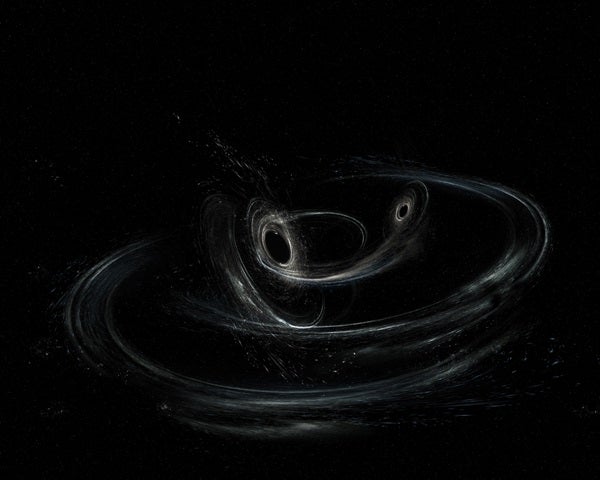On December 26, 2015, the Laser Interferometer Gravitational Wave Observatory (LIGO) made its second detection of gravitational waves as two black holes spiraled ever closer, finally merging into a single object. This signal, the lowest-mass black hole merger detected to date, also indicated that at least one of the two black holes was spinning. The source of its spin, astronomers now believe, is the death of the massive star that spawned it.
It is the first time a nonzero spin has been detected from a pair of merging black holes. Richard O’Shaughnessy, a researcher at the Rochester Institute of Technology (RIT), announced the finding on Monday, June 5, at the 230th Meeting of the American Astronomical Society in Austin, Texas. The work will also appear in Physical Review Letters.
The result comes from a reanalysis of the data taken as the black hole GW151226 formed in the December merger. GW151226 is 21 times the mass of the Sun and sits about 1.4 billion light-years away.
Because of their small size, the black holes that created GW151226 radiated gravitational waves slower than a pair of more massive black holes, generating the longest signal the detector has seen. This allowed astronomers to tease out information not obtainable from other detections. “LIGO detects the emission of gravitational waves. And it infers what the black holes were by using those waves. The more waves it collects, the stronger the conclusions it can draw,” said O’Shaughnessy at a press conference Monday morning.
“There is only one black hole that we’ve seen so far where we can definitively have evidence that we’re sure that one of the black holes is spinning. And that’s this one,” he said. “Moreover, there is indications … that one of the black holes is tilted.”
O’Shaughnessy and his colleagues, Davide Gerosa of Caltech and Daniel Wysocki of RIT, used the LIGO data taken during the 2015 event to determine that the larger of the two progenitor black holes responsible for GW151226 had a spin axis misaligned from its partner’s by between 25 and 80 degrees. How could they tell? The data showed the tilted black hole’s spin axis precessing, or slowly circling like a wobbly top, before the pair merged.
“This is a challenge and an opportunity to figure out how this formed,” O’Shaughnessy explained. Pairs of black holes that began as two binary stars formed from the same gas cloud are expected to have similar spin axes, not ones that are so misaligned; it’s much like the way the planets in the solar system have similar spin axes (barring catastrophic events like collisions, but those shouldn’t occur in a simple two-star system).
So why the difference in this pair? O’Shaughnessy’s group says it’s likely the result of a “kick” imparted on the black hole by its parent star at the moment of its death as a supernova. From there, the misalignment arose. “Once you kick the orbit, the orbital plane changes and the binary can become tilted,” he explained.
These kicks are already well-documented for neutron stars, but not black holes. O’Shaughnessy’s team went on to calculate how big this kick would need to be to explain the observed difference in the black holes’ axes. They reached a significant conclusion: “It would be difficult – it is very unlikely – to have a black hole tilted by the angle that we see until you start kicking black holes by a characteristic speed of 50 to almost 100 kilometers a second, which is quite substantial,” O’Shaughnessy said.
This finding is particularly interesting because it’s not easy to explain these natal kicks with the current working theory of supernovae – which is, admittedly, still vague in certain areas, as astronomers continue to seek clarification of the processes involved. Alternatively, if the star that formed the black hole simply collapsed, it wouldn’t have lost much material (or angular momentum) at all. And even less is known about the collapse scenario, which has only been detected a few times.
“What we can say with confidence is that one of LIGO’s black holes has a tilted orbit and a strong black hole birth kick will allow us to reproduce the data. If this is so, then this will be a serious challenge for supernova modelers to explain. But … this is something that is consistent with observations to date that have provided tentative support for black hole kicks” in other systems, O’Shaughnessy explained.
He concluded by stressing that astronomers won’t have to wait for bigger, better instruments to determine whether a kick is the reason for the misalignment or not. “This will be testable now.” While there are several ways to end up with a binary system like the one that formed GW151226, looking at existing archival data and examining future LIGO observations (which O’Shaughnessy hopes will appear with increasing regularity) will allow astronomers to confirm or challenge the idea of black hole kicks, as well as better constrain the magnitude of the kicks if they’re responsible for spin axis misalignment.
Thus, gravitational wave astrophysics continues to open new windows of opportunity for studying black holes, not only by looking at their behavior when they merge, but by peering back in time to see the events that led to their initial formation as well.










